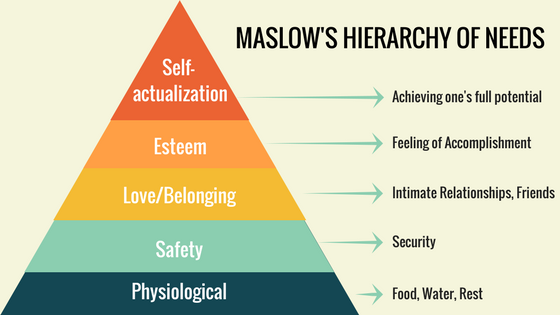There are all kinds of proverbs about achieving higher planes, clearing one’s mind, body, and soul of all that would tarnish it and hold it down, and discovering inner peace through outer application of discipline, mindfulness, and grace. Some even anticipate receiving total consciousness on their deathbeds.
This isn’t about any of that.
“Shelf actualization is what Retail Insight considers the gold standard of retail execution,” said Paul Boyle, CEO of Retail Insight. “It represents stores operating at their full potential and delivering optimization across all aspects of supply chain, sustainability, profitability, and knowledge.”
Boyle said the strategy is inspired by Abraham Maslow’s Hierarchy of Needs. The Hierarchy of Needs is an idea first proposed by Maslow in 1943 in the journal Psychological Review, which is a classification system to reflect the universal needs of society and has been used as an assessment tool in education, social work, and healthcare.
Using Retail Insight’s own levels of the pyramid – if you will – Boyle said, “Once retailers excel across all of these areas, they’ll be equipped to make better, data-driven decisions that enable them to sell more, waste less, and grow profits, thus achieving shelf actualization.”
Per Retail Insight’s data analysis, 51% of grocers don’t use data accurately in day-to-day decision making. That is an astounding number but maybe not surprising considering the billions of possible data points available the more a grocer or retailer invests in sales- and traffic-tracking systems given the sheer volume of tools on hand to enhance service and bolster ROI.
“Grocers now have more technology at their disposal than ever before, and effectively leveraging this data to drive in-store performance has become increasingly difficult,” Boyle said.
“Large-scale investments in ambiguous tools and technologies have created a complex data ecosystem to manage and navigate. As a result, extracting the necessary information to support decision-making within store operations becomes a minefield.”
Boyle said the best place to start to address these challenges is to simplify all available data and then focus on what really matters to create clear decisions via actionable insights specific to that store, or that market. Boyle said there are many valuable solutions that simply require sales and inventory data, for example, to transform inventory management and replenishment.
In a time of high food prices and more conservative shoppers, Boyle said 45% of grocers struggle ensuring on-shelf availability so customers can find what they need every time they shop without having to visit another store or order from another competitor.
“On-shelf availability is undoubtedly one of the perennial challenges in food retail. It can cost retailers up to 8% in lost sales opportunities every year, massively frustrate shoppers, risk damaging loyalty, and increase the chance of retailer switching. Getting it right is crucial.”
Boyle added that factors such as bad data, inaccurate replenishment, and poor processes are common factors that may appear small in the day-to-day operations but represent massive failures of management to ensure shopper satisfaction.
“Many stores do not have the ability to properly mitigate the impact of short deliveries, mis-scans, and total loss, so they end up suffering from phantom inventory,” he said. “This causes lags in inventory replenishment and results in widespread availability problems.”
Boyle said to get a true picture of their inventory levels and reach shelf actualization, grocers can utilize advanced, cognitive technology, which blends subject matter expertise and AI. Only then will retailers have an accurate picture of their inventory for distributors, manufacturers, and in-store associates.
Assessing High-Value Actions Within the Store
Data from Retail Insight says 43% of grocers fail to allocate enough time for associates to deliver customer experience nor use data properly to focus resources on the highest-value actions within the store.
Recent pullbacks in self-checkout have forced the greater industry to consider where the line between consumer proactive self-scans and payment and employee-assisted service lies; Boyle said customer experience is a massive high-value action because it improves the shopping experience and fosters loyalty.
“The challenge with store associate allocation, however, typically results from the volume and variety of tasks they are expected to carry out within a limited timeframe. This typically happens when retailers don’t have access to the right data to direct staff accordingly. As a result, they have to rely on manual actions from their store associates to drive action which is neither profitable nor efficient.”
Boyle said some of the biggest value can be extracted from addressing “quick wins” across product availability and inventory and waste processes without huge capital expenditure. Boyle advised to use foundational data to help automate inventory record updates, alert staff to near-expiring products and availability challenges, and create dynamic markdowns.
“In doing so, you focus store associate time on some of the highest value actions, freeing your store associates up to serve and sell.”
Reliable labor remains a huge wrench in the cogs of grocers and retailers everywhere. Boyle said 42% of grocers fail to deploy store associates to tasks that have the highest impact on sales, and 41% of grocers fail to ensure their staff are clear on replenishment tasks.
“Labor is a huge factor in whether a retailer is successful or not,” he said, adding that there are over 500,000 vacancies within retail today, while associate turnover is 60% or more on average. What’s more, retailers are struggling to retain labor once they come through the door.
“Data provides the key for retailers to boost the productivity of store associates, whether through automating mundane tasks or through highly targeted intervention alerts that enable them to be deployed as efficiently as possible,” he added, “meaning associates can be freed up from tasks like product audits or gap scans to serve and sell to their customers.”
He also said using data to streamline these processes has also never been easier.
“Cognitive technology can create highly sophisticated models that can predict where gaps on the shelf or phantom inventory may exist, or predict which items are at risk of being wasted or not. These technologies can be deployed in a simple and scalable way, meaning it is easy for retailers to create connected associates and highly impactful store teams.”
Boyle admitted that these are ubiquitous, evergreen challenges, and that what worked yesterday may not work today, and that what works today may not work tomorrow. Nonetheless, technology can help maintain equilibrium in the tricky balancing act between internal overhaul and external revenue loss from customers too spooked by too many changes too quickly to return.
“From robotics to electronic shelf-edge labels and digital fridge displays, there is no end to innovation in the space,” he said. “But the retailers that are getting it right understand that they need to get back to basics. By rationalizing and simplifying their existing data, they can extract significant value across their estate.”
Boyle said he’s seen several retailers embrace this mindset with “fantastic results,” including Sprouts and Kroger.
“Sprouts has seen sales and margins improve while freeing up labor hours, whilst Kroger has used our data-driven approach to contribute towards its Zero Hunger, Zero Waste initiative.”
Shelf Actualizing Produce
Produce is notoriously tricky to master as seen by major retailers’ inability to really get it right. Boyle said shoppers desire to see an abundance of fresh produce, especially because its presentation and availability can set the scene for consumers’ experience of the store. Fresh product spoils quickly, however, and there’s no easy answer to this perennial dilemma.
“The ultimate aim is to always have just enough availability with little-to-no waste. In today’s climate of sustainability challenges and tightening margins, maximizing sales of fresh products is essential,” he said.
“Luckily, stores can reach shelf actualization by implementing dynamic markdowns on their produce and other expiring products throughout the store. To do this, retailers can use historic sales trends and data on product type, seasonality, and more to make dynamic markdowns at a price that optimizes the chance of product sell-through and maximizes the profit margin for the retailer.”
Boyle stressed that the price that customers see at a given point in time should be a “sweet spot” for both themselves and the retailer, ensuring that more product flows off shelves and doesn’t end up in the trash.
There are myriad tools to help run a store at its maximum potential. Shelf actualization is one, and food/bev executives can rest assured that using any data at all is better than the alternative. Identifying one’s hierarchy of needs in a grocery and retail setting is merely a matter of accurate inventory, crisp decision making, and understanding that the input of consumers and output of sales isn’t a static system – it requires constant re-evaluation and renewal.
The more data one has, however, the clearer the picture gets.













